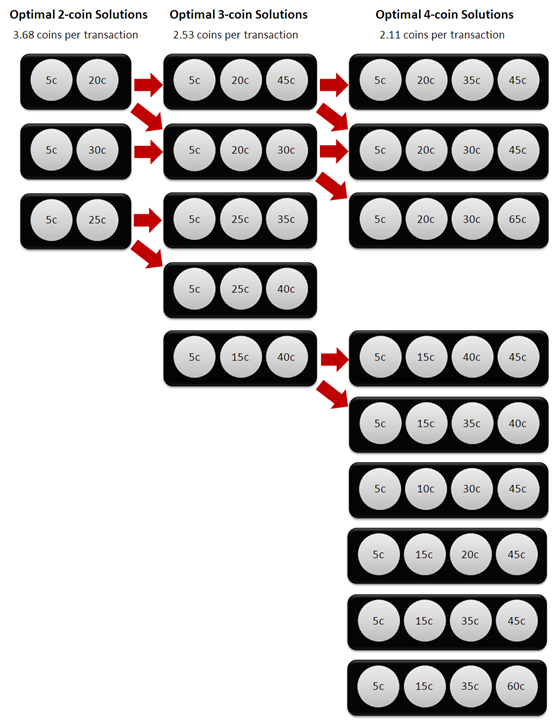We Still Don't Need No 37-cent Piece (And I'm Going Right Off The 10-cent Piece)
A few blogs back we asked and answered the question: if you were to select a set of four coin denominations on the basis that the selected four could combine to make any amount from 5-cents to 95-cents using, on average, the fewest number of them, what would those four denominations be?
There were, it turned out, nine such sets each of which was optimal and required only 2.11 coins, on average, to sum to any amount from 5-cents to 95-cents.
Well since we've solved the problem for 4-coin sets, what about solving it for 2-coin and 3-coin sets?
Only three 2-coin solutions are optimal - (5,20), (5,25) and (5,30) - and each of them requires 3.68 coins on average to produce sums from 5-cents to 95-cents. The combinations of (5,15) and (5,35) are next most efficient, each requiring an average of 4 coins per transaction.
Most efficient amongst what I'd consider to be the odd-looking solutions is (5,12), which requires 7.05 coins per transaction, an average that is bloated by horror outcomes for higher amounts such as the 14 coins required to produce a 95-cent total (5 x 12-cents + 9 x 5-cents).
Moving onto 3-coin solutions we find that there are five that are optimal - (5,15,40), (5,20,30), (5,20,45), (5,25,35) and (5,25,40) - each requiring an average of 2.53 coins per transaction. Glistening amongst the six next-most efficient solutions is (5,20,25), which has the twin virtues of being near-optimal (it requires just 2.63 coins per transaction) and of being patently practical.
Thinking some more about 3-coin solutions, if we were forced to retire one of our current coin denominations, it's the 10-cent that should go as this would leave (5,20,50), a solution that requires an average of only 2.74 coins per transaction. This is only marginally less than optimal in the 3-coin world and is actually not all that much worse than the 2.32 coin average that our current (5,10,20,50) set offers.
Instead of thinking about which of our current coin denominations we might retire, what if, instead, we thought about how we might grow an efficient set of denominations, starting with an optimal set of two coins, then adding a third coin to produce another optimal set, and then finally adding a fourth to again produce an optimal set. Can it be done?
Yes, it can, as is illustrated below.

To produce an all-the-way optimal path from two coins to four we could start with either the (5,20) or the (5,30) sets, though not with the (5,25) set since, although it would allow us to move to an optimal 3-coin solution with the addition of a 35-cent or a 40-cent coin, we would be unable to create an optimal 4-coin solution from there.
For our third coin we could either add the 20-cent coin if we'd started with (5,30), or add the 30-cent or 45-cent coin if we'd started with (5,20).
Lastly, if we'd started with (5,20,45) we could add a 30-cent or a 35-cent coin, or if instead we'd started (5,20,30) we could add a 45-cent or a 65-cent coin to produce an optimal 4-coin solution.
The only way to reach the six other equally optimal 4-coin solutions would have been to start with the sub-optimal (5,15) set, which as we noted earlier falls only a little short of the optimal solutions in requiring on average 4 coins per transaction to the optimal solutions' 3.68 coins per transaction.
I am, naturally, curious about the optimal 5-coin solution (and the 6-coin, and so on) but I don't think that I can find this solution in a practically feasible amount of time using the integer programming optimisation routine that I am currently. Perhaps more at a future date, though probably not.